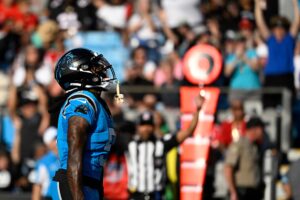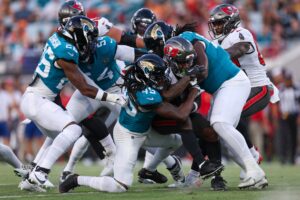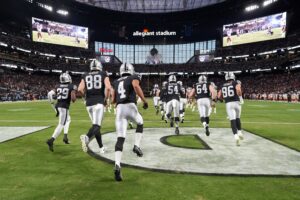After doing a few fantasy mock drafts this off-season, it’s easy to identify the top three fantasy football running backs regardless of scoring format. In any order they are: David Johnson, Ezekiel Elliott, and Le’Veon Bell. All three dominate touches, are primary goal line options, and legitimate receiving threats in the passing game.
After those three? The field is completely wide open.
Depending on format, scoring, and personal preference the best draft order for the remaining fantasy running backs is very debatable. One of the most revealing ways to handicap the field is using running backs receptions. In a pass heavy league, very few fantasy RB1s can exist without robust reception volume.
The LeGarrette Blounts of the world are few and far between.
Taking a close look at last year’s top teams for running back pass catching production provides a window to find some great fantasy value. (All statistics from PlayerProfiler).
Fantasy Football: The Magic of Running Back Receptions
Here are the top 10 teams in terms of running back receptions from 2016.
| Team | Receptions | Yards | TDs |
| New Orleans | 127 | 884 | 10 |
| Baltimore | 107 | 689 | 2 |
| Pittsburgh | 98 | 772 | 4 |
| Atlanta | 98 | 1005 | 6 |
| Cleveland | 97 | 860 | 0 |
| Oakland | 95 | 843 | 3 |
| New England | 94 | 760 | 6 |
| Arizona | 93 | 970 | 4 |
| New York Jets | 91 | 678 | 3 |
| Detroit | 87 | 684 | 6 |
Three teams jump out immediately: New Orleans, Baltimore, and Cleveland. All three return the same offensive coordinators, but lack that one standout receiving back. Teams like Pittsburgh (Le’Veon Bell, 75 receptions) and Arizona (David Johnson, 80 receptions) are relatively easy to analyze. But the key is to analyze the other three teams and maximize the high fantasy return on investment their running backs offer.
New Orleans Saints Running Back Reception Breakdown
The Saints always make a concerted effort to get their running backs involved in the passing game and loyal fantasy owners are rewarded. Of particular note are the ten receiving touchdowns by their running backs, four more any other NFL team in 2016. Their individual running back reception breakdown was as follows:
| Player | Rec | Yds | Yds/Rec | Long | TD |
| Mark Ingram | 46 | 319 | 6.9 | 22 | 4 |
| Travaris Cadet | 40 | 281 | 7 | 25 | 4 |
| Tim Hightower | 22 | 200 | 9.1 | 50 | 1 |
| John Kuhn | 16 | 70 | 4.4 | 11 | 1 |
| Daniel Lasco | 2 | 11 | 5.5 | 7 | 0 |
| Marcus Murphy | 1 | 3 | 3 | 3 | 0 |
With Tim Hightower now in San Francisco and future Hall of Famer Adrian Peterson taking his place, projecting the New Orleans running back reception distribution is difficult but essential for 2017 fantasy drafts. Let’s examine the main players:
- Adrian Peterson: He signed a two year, $7 million contract in April, and his job will include scoring from the goal line. It was clear last season that head coach Sean Payton lost faith in Mark Ingram to do that job, especially after this Week 15 incident in Arizona.
However, it is highly unlikely that the 32-year-old Peterson will get a normal workload and even less likely he sees the field on third downs. In 2016, Peterson only played three games and the Saints want to keep him fresh for an expected playoff run late in the season. He will also not be deployed in the two minute offense. As far as receptions, Peterson projects to around 30, which would be the fourth highest total of his career.
- Mark Ingram: For a while, it seemed as if Mark Ingram would be playing for a different team. Things have quieted down over the last week, so let’s assume he stays in New Orleans all season. Ingram has 96 total receptions over the past two seasons and scored four receiving touchdowns in 2016. He is also a much better pass blocker than Peterson, which will likely keep him as the starter.
Over the past three seasons, no running back has posted a higher catch percentage *or* better drop percentage than @MarkIngram22. pic.twitter.com/k0UOCpLvfZ
— Scott Barrett (@ScottBarrettDFB) May 12, 2017
Assuming Ingram stays in New Orleans, he is being undervalued at his current RB18 ADP. There should not be much concern about Peterson’s arrival, since Ingram was already losing goal line work to Tim Hightower last season and still finished tenth in fantasy points per game in PPR formats.
- Travaris Cadet: The 28-year-old undrafted product out of Appalachian State has made himself a nice seven-year NFL career. His 40 receptions last season are certainly worthy of a mention, but he is not as talented as Ingram and only produced a 26.1 percent Snap Share in 2016. He is not a fantasy viable option, especially because of who the Saints just drafted.
- Alvin Kamara: New Orleans traded their 2018 second round pick and their 2017 seventh round pick to San Francisco to select Tennessee running back Alvin Kamara. He is a talented pass catching running back who produced a 14.0 percent (90th Percentile) College Target Share. Head coach Sean Payton already sees Kamara having a potential Darren Sproles type impact.
Payton on what he expects out of rookie RB Alvin Kamara #Saints https://t.co/IRmYauIkwC
— New Orleans Saints (@Saints) May 14, 2017
The fantasy instinct here is to assume that Alvin Kamara will automatically be the Saints exclusive third down running back. That is a foolish assumption. New Orleans will put an emphasis on pass blocking for their 38-year-old star quarterback Drew Brees, which means Mark Ingram will dominate the passing down work. Kamara will certainly be deployed in a variety of ways, but unless Ingram is traded, he will be not be a reliable running back fantasy option in 2016.
New Orleans Backfield Fantasy Summary: It is always productive to have a piece of the Saints backfield in fantasy football, especially in PPR formats. Adrian Peterson will be a better option in standard formats, but the key player in Mark Ingram. If he stays in New Orleans, he will still carry an RB2 floor in PPR leagues. Rookie Alvin Kamara is a great choice in dynasty leagues, but will have a limited fantasy impact during his rookie season.
Cleveland Browns Running Back Reception Breakdown
The Cleveland Browns were one of the clear winners of the 2017 NFL draft, and they also possess two of the most underrated fantasy running backs. They have coaching continuity and return the same starting backfield as last season. The Browns only had three total running backs catch passes last season.
| Player | Rec | Yds | Yds/Rec | Long | TD |
| Duke Johnson | 53 | 514 | 9.7 | 32 | 0 |
| Isaiah Crowell | 40 | 319 | 8 | 44 | 0 |
| Danny Vitale | 4 | 27 | 6.8 | 17 | 0 |
With Hue Jackson returning as head coach/offensive coordinator, it is safe to project another 100 reception season by Cleveland running backs. Last season, Isaiah Crowell produced ten weeks of top 24 fantasy running back PPR production and five weeks of RB1 level production. He more than doubled his previous year reception total from 19 to 40, which is no surprise in Hue Jackson’s first season as head coach.
Crowell finished 15th among all running backs in total fantasy points and total rushing yards, despite facing a pass heavy game script during Cleveland’s 1-15 season. He showed big play ability, ranking seventh among all running backs with 13 breakaway runs (15 yards or more), and finished tenth among running backs in yards after contact.
Isaiah Crowell is undervalued in current MFL10 drafts, ranking as the 18th running back off the board. But the fantasy community is starting to catch on to his 2017 potential.
crowell is going to EAT this season. i want it all.https://t.co/7D0oEeniCr
— the podfather™️ (@Fantasy_Mansion) May 11, 2017
His backfield mate is third year Miami product Duke Johnson. In 2016, Johnson took a step backwards from his 61 catch rookie season. He received the same amount of targets but had 29 less rushing attempts. Johnson still presents a skill set that is a huge fantasy asset in PPR formats. He has finished top five among all running backs in receptions and receiving yards during his first two seasons. Johnson has 4.54 40-yard dash speed and a 11.03 (83rd Percentile) Agility Score.
Johnson is also criminally undervalued, currently maintaining a 147.58 ADP. He is the 41st running back off the board, behind unproven pass catching commodities like Kareem Hunt, D’Onta Foreman, and Samaje Perine. He should be targeted in all PPR formats as a solid RB2 option.
Cleveland only added one new running back to the roster with seventh round draft pick Matthew Dayes of NC State. Standing only 5’9″, Dayes brings excellent passing game production having caught 98 passes in his college career. Clearly, Hue Jackson will have all his running backs active in the passing game throughout the season.
Cleveland Backfield Fantasy Summary: Isaiah Crowell has RB1 value yet has a seventh round ADP. It is easy to envision 1,500 total yards, 50 receptions, and double digit touchdowns for his upcoming season. The Browns believe in Duke Johnson, which is illustrated by their decision to not draft a running back until the seventh round. The Browns have a sneaky fantasy backfield that should be targeted with confidence.
Baltimore Ravens Running Back Reception Breakdown
The Ravens’ free agent running back acquisition was very noteworthy.
Baltimore threw the ball to their running backs over 100 times last season and now added one of the best pass catching running backs in the league in Danny Woodhead. Same coach, same offensive coordinator, and a new shiny toy in the passing game.
The running back position has been an integral part of the Baltimore offense since John Harbaugh’s arrival in 2008.
Since John Harbaugh took over as head coach (2008), the Ravens are the only team to rank top-5 in both team running back targets and carries https://t.co/T3Z0maCM3g
— Scott Barrett (@ScottBarrettDFB) May 14, 2017
The confounding variable in Baltimore is second-year running back Kenneth Dixon, who is suspended for the first four games of the season due to a positive PED test. This was a shock to the Ravens offense as Dixon was expected to challenge for the lead running back role. Certainly, his future with Baltimore is now in jeopardy.
That starting spot is held by fifth-year running back Terrance West, who performed admirably last season. He finished with 1,010 total yards, 34 receptions, and six total touchdowns. West is simply a solid running back who fails to excels in any one area. As the probable goal line running back for at least the first four games, his current RB56 ADP does provide early season value.
However, the real fantasy prize here is Danny Woodhead. Take a look at his fantasy finishes in PPR and standard leagues during his career:
| Year | Team | Games | RU ATT | RU YD | RUTD | RECPT | REYD | RETD | STD Rank | PPR Rank |
| 2016 | SD | 2 | 19 | 116 | 0 | 6 | 35 | 1 | —— | —— |
| 2015 | SD | 16 | 98 | 336 | 3 | 80 | 755 | 6 | 13th | 3rd |
| 2014 | SD | 3 | 15 | 38 | 0 | 5 | 34 | 0 | —— | —— |
| 2013 | SD | 16 | 106 | 429 | 2 | 76 | 605 | 6 | 16th | 12th |
| 2012 | NE | 16 | 76 | 301 | 4 | 40 | 446 | 3 | 16th | 24th |
| 2011 | NE | 15 | 77 | 351 | 1 | 18 | 157 | 0 | —— | —— |
| 2010 | NE | 14 | 97 | 547 | 5 | 34 | 379 | 1 | 29th | 25th |
While he is 32 years old, Danny Woodhead still has plenty of fantasy tread left on his tires. He missed two of the last three seasons with unrelated injuries. In 2014, he missed 13 games with a fractured ankle/fibula, and in 2016, he torn his ACL during the second week of the season.
But during his last three full campaigns, Danny Woodhead always produced at least an RB2 season, including in 2015 when he was the third best fantasy running back overall in PPR leagues. His last two seasons have produced 156 total receptions, while sharing touches with Ryan Matthews (2013) and Melvin Gordon (2015). Combining both years, Woodhead received 204 total rushing attempts to 469 for Matthews and Gordon.
Conclusion? Danny Woodhead doesn’t need rushing attempts to be fantasy productive.
Therefore, with a Baltimore backfield of simply Terrance West, Kenneth Dixon (Week Five), and fullback Lorenzo Taliaferro, Woodhead should make a huge impact and return substantially higher value than his current RB47 ADP.
Baltimore Backfield Fantasy Summary:
Danny Woodhead is one of the best fantasy values in PPR formats. He can be acquired for a microscopic 14th round pick. Terrence West is a solid late round choice that can help fantasy teams get off to a good start. The most difficult player to project is Kenneth Dixon, who has a wide range of outcome possibilities when he returns in Week Five. The Baltimore Ravens use their running backs in the passing game as much as any team, which means there is real fantasy value in their running backs.
Summary
The most productive fantasy running backs are also skilled receivers out of the backfield. New Orleans, Cleveland, and Baltimore all provide a myriad of viable fantasy backfield options in the mid to late rounds of drafts. The top running backs are clearly delineated, but if you aren’t in a position to draft any of those “big three,” make sure to take a close look at players like Mark Ingram, Isaiah Crowell, Duke Johnson, and Danny Woodhead. All represent low risk but high fantasy reward.






